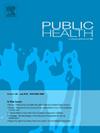使用潜在类别增长分析的三重灾难后纵向健康检查访问模式:福岛健康管理调查
IF 3.9
3区 医学
Q1 PUBLIC, ENVIRONMENTAL & OCCUPATIONAL HEALTH
引用次数: 0
摘要
目的本研究的目的是评估受日本福岛三重灾难影响最严重的城市居民获得健康检查的纵向模式。研究设计前瞻性队列研究。方法研究对象为日本福岛12个市的居民。2011年3月11日至2012年4月1日期间,这些城市的所有居民都有资格接受全面健康检查。数据来自2021年福岛健康管理调查。研究人员分析了东日本大地震发生时年龄≥20岁的167,479名参与者的完整数据,包括年龄、性别、城市(2011年、2017年)和2011年至2018年的健康检查次数。还报告了年度健康检查参与率。采用潜在类别增长分析对获得健康检查的轨迹进行分类,并采用多项逻辑回归分析确定与每组相关的因素。结果2011年参加健康体检的参与者比例为29.7%,2018年降至19.9%。纵向健康检查模式组为:(1)健康检查频次高(15.2%);(2)拒绝接受体检(19.3%);(3)很少接受检查(65.5%)。值得注意的是,女性和老年人与频繁参加健康检查呈正相关。结论灾后健康检查参与率随时间的推移而下降。需要采取综合战略,促进参与健康检查。本文章由计算机程序翻译,如有差异,请以英文原文为准。
Longitudinal health checkup access pattern following a triple disaster using latent class growth analysis: The Fukushima Health Management Survey
Objectives
The aim of this study was to assess the longitudinal patterns of access to health checkups among residents of municipalities most affected by the triple disaster in Fukushima, Japan.
Study design
A prospective cohort study.
Methods
Participants included residents in 12 municipalities in Fukushima, Japan. All residents in these municipalities were eligible for the Comprehensive Health Check between 11 March 2011 and 1 April 2012. Data were sourced from the Fukushima Health Management Survey in 2021. A total of 167,479 participants aged ≥20 years at the time of the Great East Japan earthquake disaster, with complete data on age, sex, municipality (2011, 2017) and health checkup visits between 2011 and 2018, were analysed. Annual health checkup participation rates were also reported. Latent class growth analysis was performed to classify the trajectory of access to health checkups, and multinomial logistic regression analysis was performed to determine factors associated with each group.
Results
In total, 29.7 % of participants accessed the health checkup in 2011, decreasing to 19.9 % in 2018. This study identified the following three longitudinal health checkup pattern groups: (1) frequent access to health checkups (15.2 %); (2) declining access to checkups (19.3 %); and (3) rare access to checkups (65.5 %). Notably, females and older adults were positively associated with frequent health checkup participation.
Conclusions
Participation in health checkups declined over time following the disaster. Comprehensive strategies are needed to promote participation in health checkups.
求助全文
通过发布文献求助,成功后即可免费获取论文全文。
去求助
来源期刊

Public Health
医学-公共卫生、环境卫生与职业卫生
CiteScore
7.60
自引率
0.00%
发文量
280
审稿时长
37 days
期刊介绍:
Public Health is an international, multidisciplinary peer-reviewed journal. It publishes original papers, reviews and short reports on all aspects of the science, philosophy, and practice of public health.
 求助内容:
求助内容: 应助结果提醒方式:
应助结果提醒方式:


